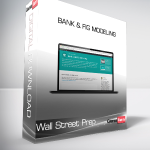Description
Wall Street Prep – Bank & FIG Modeling

Developed for FIG-focused investment bankers, equity research analysts and corporate finance teams at banks, this course guides trainees through a bank’s financial statements, unique drivers, and regulatory framework. Please note, this bank & FIG modeling course is sold as a PDF E-Book and no video component.
Course Objective

At completion, trainees will have built a fully integrated financial statement model, RI model and DDM
The analysis of banks is different from that of most other types of industries. As a result, analysis requires adjustments and different approaches from traditional valuation methodologies. Wall Street Prep’s bank modeling course will guide you step-by-step through a bank’s financial statements, unique drivers and regulatory framework. You will build a fully integrated financial statement model, a residual income (RI) model, and a dividend discount model (DDM) using Valley National Bank as a case study.
What You Will Learn
Section One: Building a Bank Forecast Model
- Build an advanced bank forecast model, projecting asset and liability balances, interest rates and spreads for key assets and liabilities, using industry best practices
- Learn to effectively forecast the loan portfolio, investment securities, and deposits
- Understand the modeling and forecasting of allowances for loan losses and net charge offs (NCOs)
- Model regulatory constraints and analyze effects on leverage, capital ratios, and profitability
- Forecast net interest income (NII), asset yields, funding costs and interest earning assets (IEA) and liabilities (IBL) using an approach that takes into account typical disclosure gaps, is internally consistent, and avoids common modeling pitfalls
- Build an advanced bank forecast model, projecting asset and liability balances, interest rates and spreads for key assets and liabilities, using industry best practices
- Learn common forecast approaches for the non-interest income and expenses such as fees, and compensation
- Identify the most appropriate “plugs” in a bank model to ensure the model balances, and address circular reference issues in the model
Section Two: Building a Bank Valuation Model
- Using the results derived from the forecast model, build a residual (excess returns) income model
- Build an adjusted dividend discount model using the prevailing beset practices for banks (not the same as non-banks)
- Analyze how regulatory capital constraints effect valuation
- Develop assumptions about return on equity (ROE), risk weight assets (RWA), cost of equity, and minimal capital ratio that are internally consistent for a multiple stage model
- Compare the other valuation approaches such as comps and DCF and identify strengths and limitations of each approach
Course Highlights

Real World “On the Job” Investment Banking Training
The Bank Modeling Self Study Program bridges the gap between academics and the real world to equip industry professionals with the practical financial skill set they need on the job. The program utilizes a case study format, as students follow their tutorial guide alongside the Excel model templates, and are directed to the appropriate external documents (SEC filings, research reports, etc.) in order to build complex financial & valuation models the way they would on the job.

Support Center
Upon enrollment, students gain 24-month free access to Wall Street Prep’s Online Support Center, where they receive answers to questions, free downloads, and important updates.
Get Digital Download ” Wall Street Prep – Bank & FIG Modeling ” Right Now!





Reviews
There are no reviews yet.